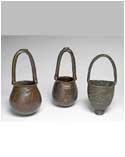

The Early Bronze Age, which dates between the second half of the fourth millennium and the end of the third millennium BCE, is divided into three chronological and cultural phases:
Early Bronze Age I (3500-2900 BCE).
Early Bronze Age II (2900-2600 BCE).
Early Bronze Age III (2600-2200 BCE).
The beginning of the period is characterized by the reestablishment of rural settlement, following the rupture that occurred at the end of the Late Chalcolithic period. The settlements, which extended through all regions of the country, were based on field crops, orchards and animal husbandry. Among the innovations that are attributed to this period are the domestication of the donkey and its use as a pack animal; the invention of the plowshare, which greatly improved field cultivation, and the increased use of copper tools – axes, adzes, chisels and awls – gradually replacing the flint implements. The close economic ties with Predynastic and Early Dynastic Egypt also characterize this period; this is manifested by a wealth of Egyptian and Canaanite artifacts that were discovered in the two regions.
Toward the end of the Early Bronze Age I a stratified rural society had developed in Israel and it seems that conditions were ripe for the formation of an urban culture characterized by fortified centers dominating economic hinterlands. These centers maintained extensive regional and inter-regional trade networks. The urbanization process was in full force and scope in the Early Bronze Age II, during which time fortified cities were founded and flourished from Tel Dan in the north to Arad in the south. The cities were distinguished by clear town-planning which included a street network, separate residential and work quarters, temples, palaces, storerooms and water reservoirs. This urban framework lasted throughout the Early Bronze Age III, despite the destruction and abandonment of a number of cities, the strengthening of other and the appearance of new ethnic components such as the “Bet Yerah Culture”. This complex economic and social system declined and was destroyed “all at once” at the end of the third millennium; the root causes and processes by which this collapse transpired have not been fully ascertained.
|







